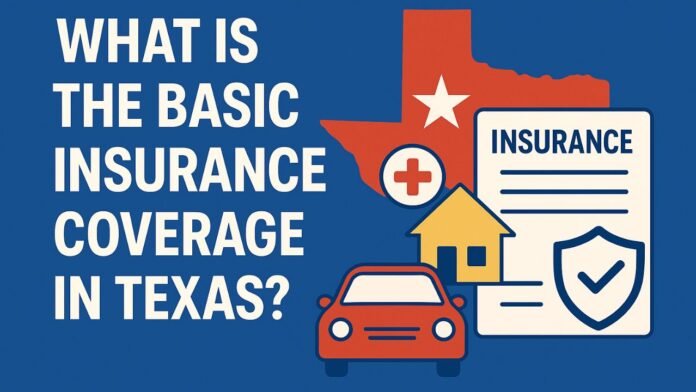In Texas, state law requires all drivers to maintain a minimum level of auto insurance before operating a vehicle. This ensures that if you are at fault in an accident, you can cover the costs of injuries or property damage caused to others. Understanding what is the basic insurance coverage in Texas is essential before purchasing a policy, as failing to meet these minimum requirements can lead to fines, license suspension, or other legal penalties. Texas insurance laws are outlined in the Texas Transportation Code, which sets specific financial responsibility standards for all motorists.
What Is the Basic Insurance Coverage in Texas?
The term “basic” or “minimum” coverage refers to the least amount of auto insurance required by Texas law to legally drive. This is designed to provide financial protection for other people and their property if you cause an accident. In Texas, the basic requirement is liability insurance, which covers bodily injury and property damage to others—but not your own injuries or vehicle repairs. While liability insurance is mandatory, other types of coverage, such as collision or comprehensive, are optional and offer additional protection.
Texas Minimum Liability Insurance Requirements
Texas law specifies that drivers must have liability coverage meeting the 30/60/25 rule:
- Bodily Injury Liability: At least $30,000 per person for injuries in an accident you cause.
- Bodily Injury Liability Total: At least $60,000 per accident, regardless of the number of people injured.
- Property Damage Liability: At least $25,000 for damage to someone else’s vehicle or property.
The 30/60/25 coverage ensures that accident victims have a way to recover costs for medical bills and property repairs. However, these amounts may not be enough in severe accidents, which is why many drivers choose higher limits or additional coverage.
Read More: How to Avoid Paying Taxes on Settlement Money?
Optional Insurance Coverage in Texas
While Texas only requires liability insurance, many drivers choose to add extra protection through optional coverages:
- Collision Coverage: Pays for repairs or replacement of your vehicle if it’s damaged in a collision, regardless of who is at fault.
- Comprehensive Coverage: Protects against non-collision damages such as theft, vandalism, fire, hail, or hitting an animal.
- Personal Injury Protection (PIP): Covers medical expenses, lost wages, and other related costs for you and your passengers, regardless of fault.
- Uninsured/Underinsured Motorist Coverage: Provides financial protection if you’re hit by a driver who has no insurance or insufficient coverage to pay for damages.
These optional coverages can help fill the gaps left by minimum liability insurance, offering peace of mind in a wider range of situations.
Other Common Types of Basic Insurance in Texas

Homeowners Insurance
While homeowners insurance isn’t required by Texas law, most mortgage lenders will require you to carry it to protect their investment. A standard homeowners policy typically includes:
- Dwelling coverage – Pays to repair or rebuild your home after covered damage (e.g., fire, wind, hail).
- Personal property coverage – Protects belongings like furniture, electronics, and clothing.
- Liability coverage – Helps cover legal expenses if someone is injured on your property.
- Additional living expenses – Pays for temporary housing if your home is unlivable due to a covered loss.
Texas is known for severe weather risks like hailstorms and hurricanes, so homeowners should pay close attention to deductibles and excluded perils in their policy.
Renters Insurance
If you rent your home or apartment, renters insurance is voluntary but strongly recommended. Your landlord’s policy will usually cover the building but not your personal belongings. A typical renters’ policy includes:
- Personal property coverage for items like clothing, electronics, and furniture.
- Liability protection in case you accidentally damage property or cause injury.
- Loss of use coverage for temporary housing if your rental becomes uninhabitable.
It’s an affordable way to protect yourself—often costing less than the price of a coffee per week.
Health Insurance
Texas does not have its own state mandate for health insurance, but residents are still affected by the federal Affordable Care Act (ACA). You can get coverage through:
- Employer-sponsored plans
- The federal Health Insurance Marketplace
- Private insurance providers
While you won’t face a state penalty for being uninsured, having health insurance is vital for avoiding high medical costs and ensuring access to care.
Read More: Pedrovazpaulo Business Consultant
Why Texas Requires Minimum Liability Coverage
Texas mandates minimum liability coverage to ensure all drivers have a basic financial safety net. This requirement:
- Protects Drivers Financially: Prevents individuals from facing devastating out-of-pocket costs if they cause an accident.
- Ensures Compensation for Accident Victims: Gives injured parties a legal avenue to recover damages without relying solely on personal lawsuits.
- Impacts Accident Claims: Streamlines the claims process, as insurance companies can quickly determine coverage limits and payouts under the law.
Without these requirements, accident victims could face long delays or be left without financial recovery.
Penalties for Driving Without Insurance in Texas
Driving without the required insurance in Texas carries serious consequences:
- Fines and Legal Consequences: First offenses can result in fines up to $350, while repeat offenses can exceed $1,000, plus additional fees.
- SR-22 Requirements: Offenders may be required to file an SR-22 form—proof of financial responsibility—for up to two years, often leading to higher premiums.
- Possible License Suspension and Vehicle Impoundment: Multiple violations can result in suspension of your driver’s license, revocation of registration, and impoundment of your vehicle until proof of insurance is provided.
These penalties are intended to encourage compliance and keep uninsured drivers off Texas roads.
Read Also: 5StarsStocks.com Healthcare
When to Consider More Than the Basic Coverage
While minimum liability insurance meets Texas legal requirements, it may not fully protect you in all situations. The biggest risk of only having basic coverage is that you could be personally responsible for costs that exceed your policy limits. For example, a serious multi-vehicle accident can easily surpass the 30/60/25 limit, leaving you to pay the difference out of pocket.
Additional coverage is beneficial if you drive a high-value car, commute frequently in heavy traffic, or live in areas prone to severe weather. Medical expenses, property damage, and legal fees can quickly climb into tens or hundreds of thousands of dollars—far beyond what basic coverage will handle.
How to Choose the Right Coverage in Texas
Selecting the right insurance coverage in Texas depends on your personal circumstances. Consider the value of your vehicle, your driving habits, and your budget when deciding on coverage limits and optional add-ons. If you drive daily in congested areas or own a newer, more expensive vehicle, higher coverage limits, collision, and comprehensive insurance may be worth the investment.
Always compare quotes from multiple insurers to find the best balance between price and protection. You can also explore bundling options, such as combining auto and home insurance, which can lower your premiums while simplifying your policies.
Also Read: Commercial Loan Truerate Services
Tips for Choosing the Right Basic Coverage in Texas
- Assess Your Risks and Needs – Consider your driving habits, property value, health concerns, and financial situation to determine the level of protection you need beyond the state minimums.
- Shop Around for Quotes – Rates can vary widely between insurers, so compare at least three quotes for the same coverage limits.
- Understand Exclusions in Policies – Read the fine print to know what’s not covered, such as certain natural disasters or specific types of damage.
(FAQs) About What Is the Basic Insurance Coverage in Texas
What is the minimum car insurance required in Texas?
Texas requires drivers to carry liability insurance with at least $30,000 per injured person, $60,000 per accident for injuries, and $25,000 for property damage—often called the 30/60/25 rule.
Is PIP mandatory in Texas?
Personal Injury Protection (PIP) is not mandatory, but Texas insurers are required to offer it. You can decline it in writing if you choose not to include it in your policy.
What is an SR-22 in Texas?
An SR-22 is a form your insurer files with the state proving you carry the required insurance. It’s usually required for high-risk drivers for about two years.
Can I drive in Texas with out-of-state insurance?
Yes, as long as your out-of-state policy meets or exceeds Texas minimum coverage requirements. If it does not, you will need to adjust your coverage to comply.
How much is the average insurance premium in Texas?
Rates vary based on factors like age, driving history, and coverage type, but the average annual cost for full coverage in Texas is often between $1,700 and $2,200. Minimum coverage typically costs significantly less.
Conclusion
Basic insurance coverage in Texas ensures drivers meet the state’s 30/60/25 liability requirement, providing a safety net for accident-related costs. While this meets legal standards, it may not be enough in serious accidents, so it’s important to assess your individual needs. Consider your vehicle’s value, driving environment, and financial situation before choosing a policy. For the best protection and peace of mind, speak with a licensed insurance professional who can tailor coverage to fit your lifestyle and budget.

